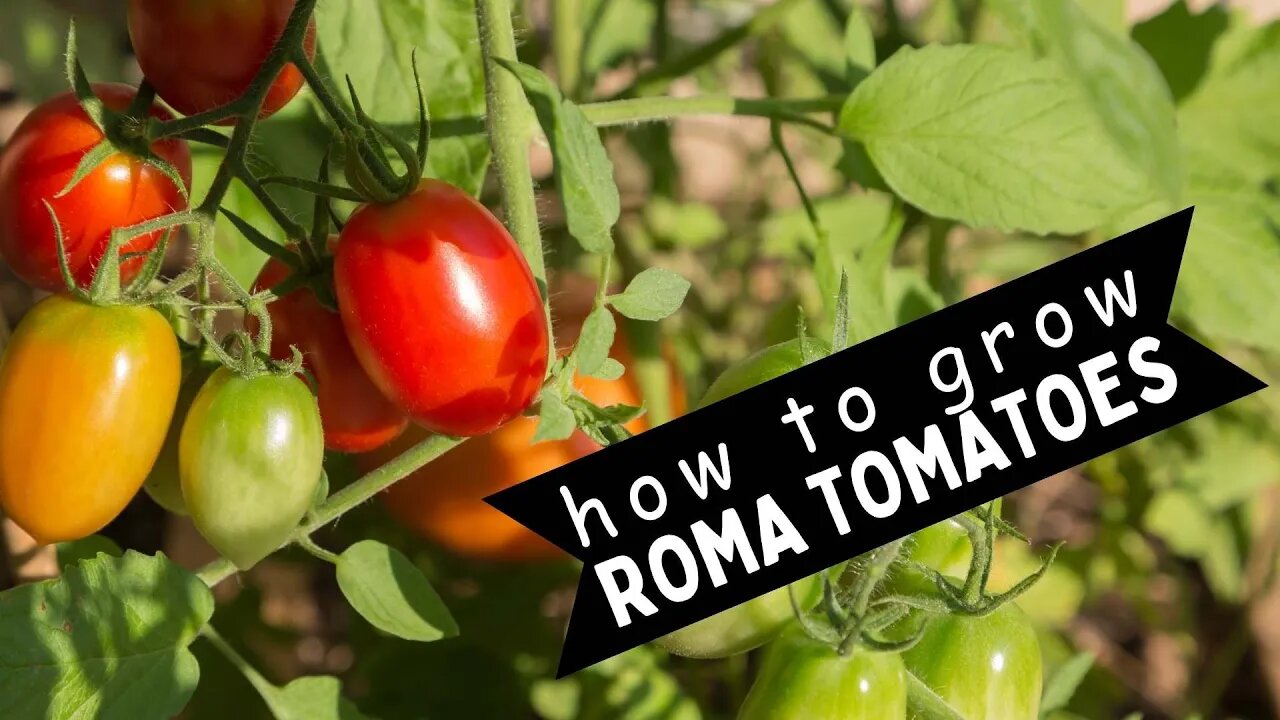Premium Only Content

ROMA TOMATOES: Bountiful Harvest Tips, Grow in the Ground or in a Container Garden
The Roma tomato plant, Latin Solanum lycopersicum 'Roma,' is a determinate tomato plant widely grown for its flavorful and meaty fruits. They're ideal for making sauces, pastes, and canning. It is a beloved variety of tomato plant due to its productivity and disease resistance.
Roma tomato plants typically grow to a mature height of 3 to 4 feet and have a compact, bushy habit. They produce oblong-shaped fruits about 3 inches long and 1.5 to 2 inches wide, with thick flesh and few seeds.
When ripe, the fruits are deep red and have a slightly sweet, tangy flavor.
The Roma tomato plant is relatively easy to grow and requires full sun and well-drained soil. It is a determinate plant, producing a large crop of tomatoes over a relatively short period, typically within one to two weeks. After this initial harvest, the plant will produce only a few new tomatoes.
This content will share information about how to use Roma tomato plants, when to harvest them, and how to grow and maintain them. We will also take a brief look at Roma tomatoes versus plums--similar in looks but different in uses. Let's explore this beautiful fruit.
Roma Tomatoes Are a Highly Versatile Fruit.
Roma tomato plants are a home garden favorite, as well as commercial tomato fields. Harvest them when the fruits are fully ripe, although they can be picked when slightly green and allowed to ripen off the vine. They are helpful in tomato paste, sauces, and other tomato-based products and adding flavor and texture to salads, sandwiches, and other dishes.
Growing the Roma Tomato Plant.
Roma tomatoes are a warm-season crop that grows best in USDA plant hardiness zones three to eleven, with a minimum temperature range of 50 to 60 degrees Fahrenheit. They require total sun exposure, at least six to eight hours of direct sunlight daily, and well-draining soil with a pH level between 6 and 7.
To plant Roma tomatoes.
Prepare the soil by adding compost or mature manure to improve soil structure and fertility.
Plant seeds indoors about six to eight weeks before the last frost in your area. Transplant the seedlings outdoors once the soil has warmed up and all danger of frost has passed.
Space the plants about two to three feet apart and provide support for them to grow upright.
Connect with us:
Facebook: https://www.facebook.com/TayloesLawnCare
Web: https://www.tayloeslawncare.com
MeWe: https://mewe.com/p/diyhomegarden
Image and music licensed via Canva Pro
-
 0:33
0:33
Garden Revelations
1 year agoCarolina Chickadees: An adorable, year-round native bird species in the southeastern United States
142 -
 3:31
3:31
SLS - Street League Skateboarding
1 day agoCoco Yoshizawa’s 3rd Place Finish at SLS Tokyo 2024 | Best Tricks
34.9K5 -
 46:15
46:15
Grant Stinchfield
1 day ago $12.15 earnedNew: The COVID Cover-up Revealed! Team Biden Caught in a Big Lie!
46.6K17 -
 2:35:08
2:35:08
The Shannon Joy Show
19 hours ago🔥🔥LIVE Exclusive W/Daniel Horowitz - New Year 2025 Analysis On Culture, Economy & Politics🔥🔥
54.2K15 -
 33:14
33:14
Tudor Dixon
4 hours agoThe World Walk with Tom Turcich | The Tudor Dixon Podcast
36.5K1 -
 7:29:48
7:29:48
PudgeTV
10 hours ago🔴 Gaming on Rumble - Marvel Rivals | Iron Man's Armory: Equipping Groot and Jeff for Battle
40.5K3 -
 1:58:48
1:58:48
The Charlie Kirk Show
4 hours ago2024 In Review + The Truth About H-1Bs | Girdusky, Carl | 12.30.24
107K39 -
 6:51
6:51
The Rubin Report
5 hours agoDave Rubin Reacts to Trump’s Greatest Moments
47.6K7 -
 DVR
DVR
Bannons War Room
1 year agoWarRoom Live
102M -
 0:57
0:57
Steven Crowder
6 hours agoCROWDER CLASSICS: AOC & the Lion’s Den (Bible Story Parody)
112K10